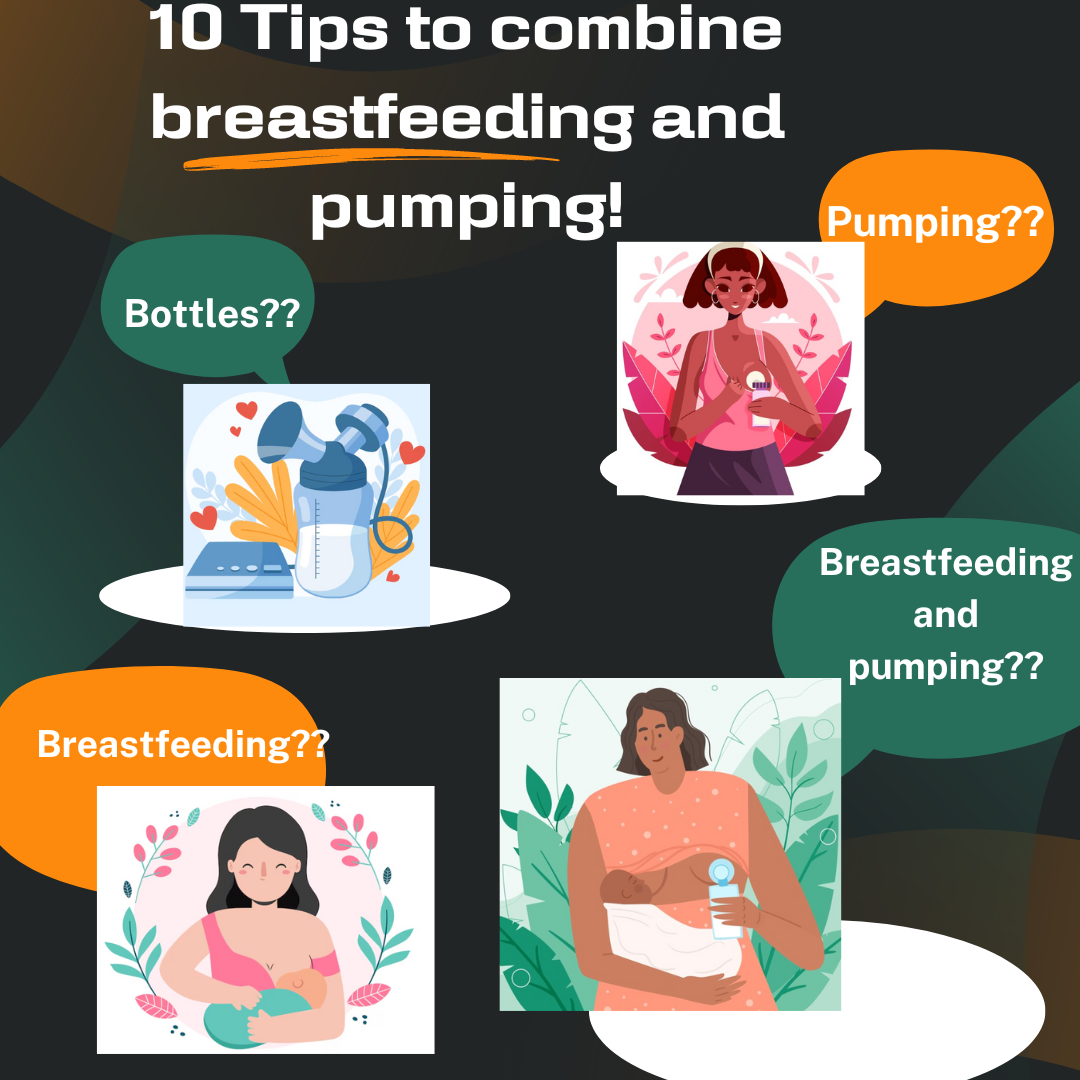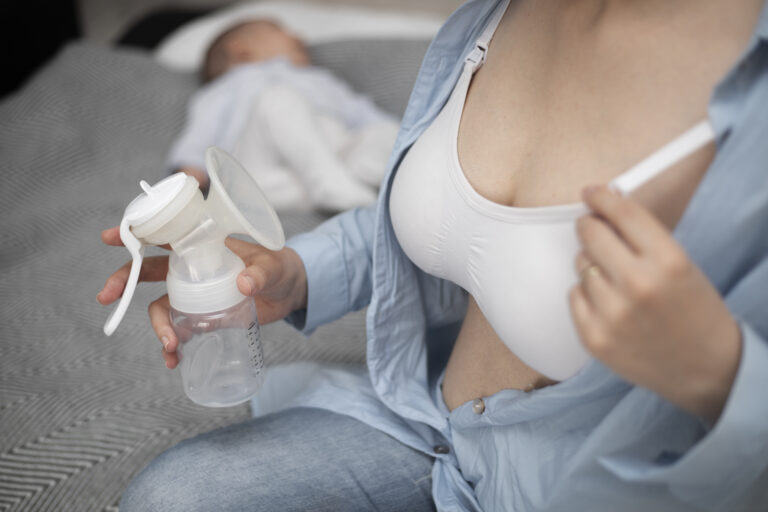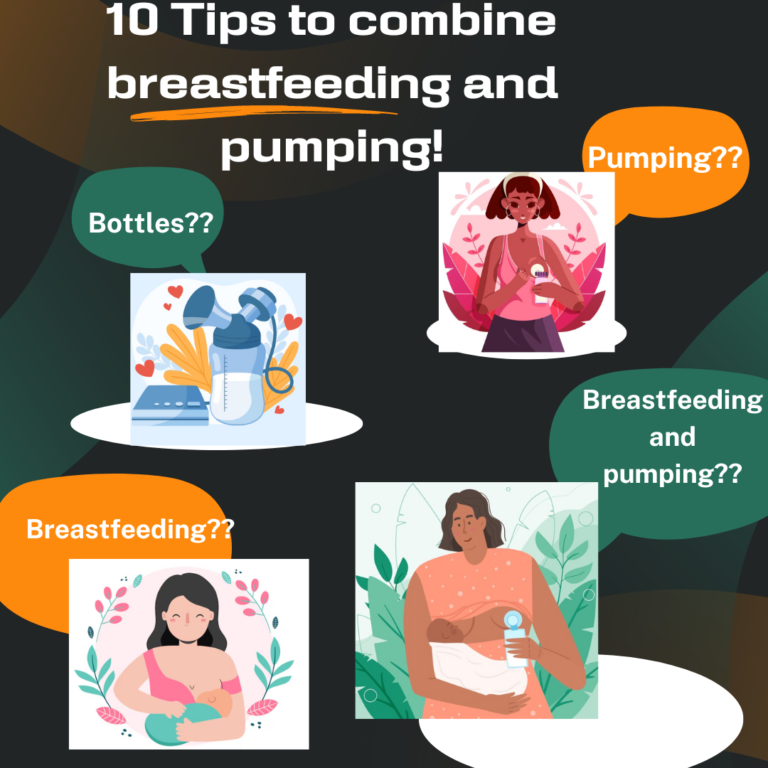10 Tips on how to combine breastfeeding and pumping!

Breastfeeding is essential for the baby to nourish their body and bond with their mother. But, we do understand that regular and frequent breastfeeding for every mother is not possible, especially for working mothers, and mothers suffering from low milk supply. So, here we are, with the best solution: combining breastfeeding and pumping. In this article we are going to give you 10 Tips to combine breastfeeding and pumping, so you don’t have to worry about your baby’s growth and development.
How to Pump and Breastfeed?
The first question that is generally asked by a lot of mothers is, “ Is it possible to combine pumping and breastfeeding?”.

The direct answer to this question is YES!
We all know that breastfeeding offers too many benefits to the baby’s behavioural, and emotional journey. But pumping and breastfeeding could be a killer combination for you to ease your breastfeeding journey, and also make it beneficial to the baby.
When you combine pumping and breastfeeding, you not only save time for relaxation, work, or giving your nipples a rest, but you also alleviate any guilt or worry about your baby’s hunger.
To enhance the benefits of pumping and breastfeeding, you need to practise it daily. Right pumping strategy along with breastfeeding is important to maintain milk supply. We will see that in detail in a moment.
How do you breastfeed and pump at the same time?
If you want to breastfeed and pump at the same time, try to incorporate double pumping.
Double pumping is when you are nursing your baby in one breast and pumping in the other breast. By doing this, you not only save time, but you can also stimulate milk production and increase the milk supply! How amazing the time process is, right?
Now, to do the double pumping, here is the summarised version of double pumping:
Step-to-step guide on how to combine breastfeeding and pumping
Combining breastfeeding and pumping has always been a great solution for working mothers, travelling parents, or when a mother is away from the baby for a few hours or 3 to 4 days.
Let’s see a detailed step-by-step guide on combining breastfeeding and pumping for a newborn.

Nursing should always be your priority as it helps in establishing a milk supply and increases the skin-to-skin contact between you and the baby. So, if you feel the baby is not getting comfortable with the pumping on the other breast, then we will recommend you avoid double pumping. Let the baby drink fully, and once the baby is full, you can start the bottle pumping.
How to Breastfeed and Pump for Storage
Storing your breast milk properly after pumping helps the baby to get enough nourishment from the milk. If you already set up a feeding routine but have to get back to work or be away from your baby, the stored milk can help you continue the routine.
It is important to store the milk in the refrigerator or freezer if you are not going to breastfeed for a longer period.
The best part is Breast milk can stay fresh even outside for 4 hours at room temperature (77°F), in the refrigerator (39°F) for four days, and in the freezer (0°F or colder) for 9 months.
When storing breast milk, make sure you are not using low-quality plastic bottles or disposable bottles as they are not made with good-quality materials. Furthermore, don’t store it near the door gasket of the fridge and freezer, as the temperature will fluctuate when you continue to take out the other things from the fridge. It will affect the quality of the milk.
How to Breastfeed and Pump to Stock Up?
Stocking up your breast milk helps you in an emergency when you have to leave your baby, or you are not well!
During these tough times, stocked-up milk provides nutrition for the baby without having to depend on formulas.
To stock up the breastmilk, pump often, whenever you see/feel there is still a milk supply after feeding the baby. Frequent pumping enhances the milk supply.
You can also try to pump after 20 to 30 minutes of nursing if you want more milk content for stocking up.
How do you breastfeed and pump to increase supply?
The point of pumping is to have enough milk supply to use when you are away or need some rest. If your milk supply is low while pumping, you can follow the below-listed steps:
- Start pumping only when you establish the proper milk supply.
- Breastfeed your baby frequently to signal your body to increase the milk supply.
- Increase the timing of nursing at each breast. At least 15 min at each breast is recommended.
- Follow a healthy diet that will enhance the milk supply.
- Increase your fluid intake.
- Keep the stress away from you.
- Gently massage your breast before pumping.
- Increase skin-to-skin time.
- Follow hands-on techniques to increase the supply.
- Drain the breast as fully as you can.
How to Pump and Breastfeed Without Getting Engorged?
Engorged breasts can be very painful.
Swelling, tenderness, and feeling full are some signs of engorged breasts. During pumping and breastfeeding, engorgement is a common challenge as your hormones are in full shifting in full swing.
But here are some effective strategies:
- Try to breastfeed often.
- Express the milk fully.
- Gently massage your breasts often to soften the breast.
- Feed as soon as you come out from the shower.
- Use a cold compress
10 Tips for combining breastfeeding and pumping
As a mother, it is important to know certain tips and techniques that can be a saviour for you, and combining breastfeeding and pumping is one of them:
Here we have listed 10 important tips for combining breastfeeding and pumping:
- Start with Breastfeeding: Breastfeeding allows skin-skin contact between you and the baby, thus stimulating the milk supply.
- Use Hand-Pump Techniques: Hand-pumping helps enhance the expression of milk and relieve engorgement.
- Double Pump: You must use this method, to avoid the risk of mastitis and engorgement.
- Invest in a Pump: You should always choose a pump that fits perfectly and helps you avoid nipple pain, soreness, or blocked ducts.
- Maintain a schedule: Prectible feeding routines help in milk ejection and promote better sleep for babies.
- Drain fully: Draining each breast fully ensures your baby is getting both foremilk and hindmilk.
- Maintain a warm environment: While you are nursing and pumping, you have to be in a calm environment to promote better mental health and bonding with your baby.
- Invest in your health: While nursing and pumping, you must have a nutrient-dense, balanced diet to help in faster postpartum recovery while also positively impacting your baby’s health.
- Consult professionals: If you still find it difficult to combine breastfeeding and pumping, consult lactation experts.
The above tips can help you achieve time freedom while also enhancing the love between you and your baby.
Breastfeeding and pumping schedule
You should maintain a proper breastfeeding and pumping schedule to enhance the milk supply.
Here is an example pumping schedule that you can try.
Remember, everyone’s body is different, and every baby is different. So, instead of blindly following any schedule, listen to your baby’s body and yours.
Here is our sample breastfeeding and pumping schedule you can check out:
Remember babies wake up in the middle of the night as they get hungry. So nurse your baby 3-4 times at night or incorporate cluster feeding (nurse every 1 hour).
Pros and cons of combining breastfeeding and pumping
When it comes to combining breastfeeding and pumping, there are several benefits as well as limitations attached to it.
While combining breastfeeding and Pumping works well for most mothers, it also comes with an equal share of cons. Maintaining a balance is the key!
How Often to Pump and Breastfeed?
Maintaining the frequency of Pumping and breastfeeding is important to ensure your baby receives enough nutrition and is not hungry.
While this frequency depends on the baby’s age, as a rule of thumb, breastfeed at least 12 times daily (as much as the baby needs) and pump at least eight times daily (which, of course, may change according to the baby’s needs).
If you are always with your baby, we will recommend you pump every 3 to 4 hours. If you are away from your baby, you can follow the same timings you nurse your baby.
A decent frequency of Pumping is important to maintain the milk supply.
Should I Pump After Breastfeeding?
Yes, you can pump after breastfeeding. But it depends on you! You can pump 1 hour before breastfeeding or 30 to 40 minutes after breastfeeding; it entirely depends on your convenience.
Note: Most mothers produce more milk in the morning. So we recommend you schedule your Pumping accordingly!
Should I Pump After Every Feeding?
It also depends on you. If you want to stock up the milk, you can pump it after every feeding. Or, if you are planning to replace, try pumping while feeding or after nursing.
Pumping after normal nursing helps the mothers to maintain the milk supply. The frequency of nursing is the key to proper milk supply.
Conclusion
Breastfeeding and Pumping go hand-in-hand, helping mothers in different ways. With the right strategy, proper schedule, diet, and frequency, combining breastfeeding and Pumping can help the mother maintain her milk supply while enjoying some time away from the baby.
Make sure you are educating yourself to avoid any blunders. Use hand techniques, or you can also invest in a good manual or electric pump. We hope this article helped!
FAQ’s
- How do you breastfeed and pump at the same time?
While breastfeeding in one breast, attach the pump on the other side. This way, you can do both!
- What is a good schedule for breastfeeding and Pumping?
Look for signals from your baby. Tailor a schedule for your baby’s demands and nurse or pump accordingly.
- How many times a day should I pump while breastfeeding?
In general, babies breastfeed at least 12 times a day. So, to maintain the supply, you can pump eight times a day. These timings can vary from one baby to another!










+ There are no comments
Add yours